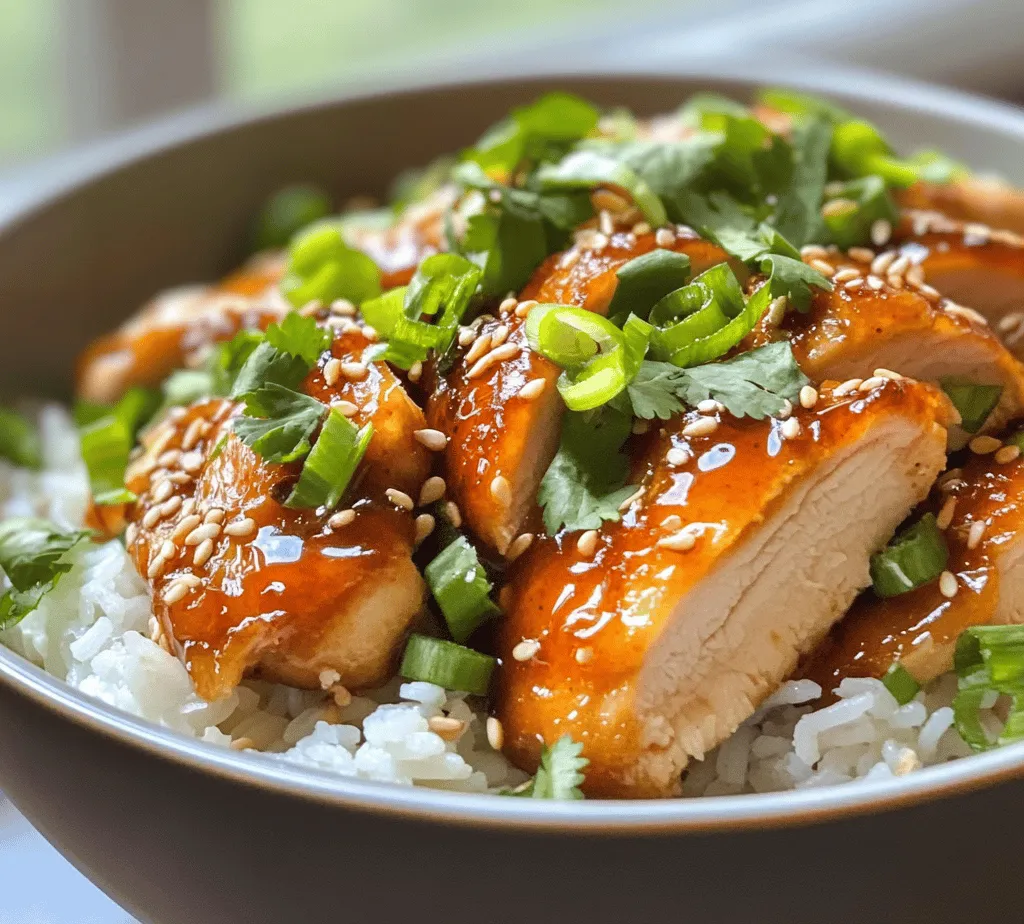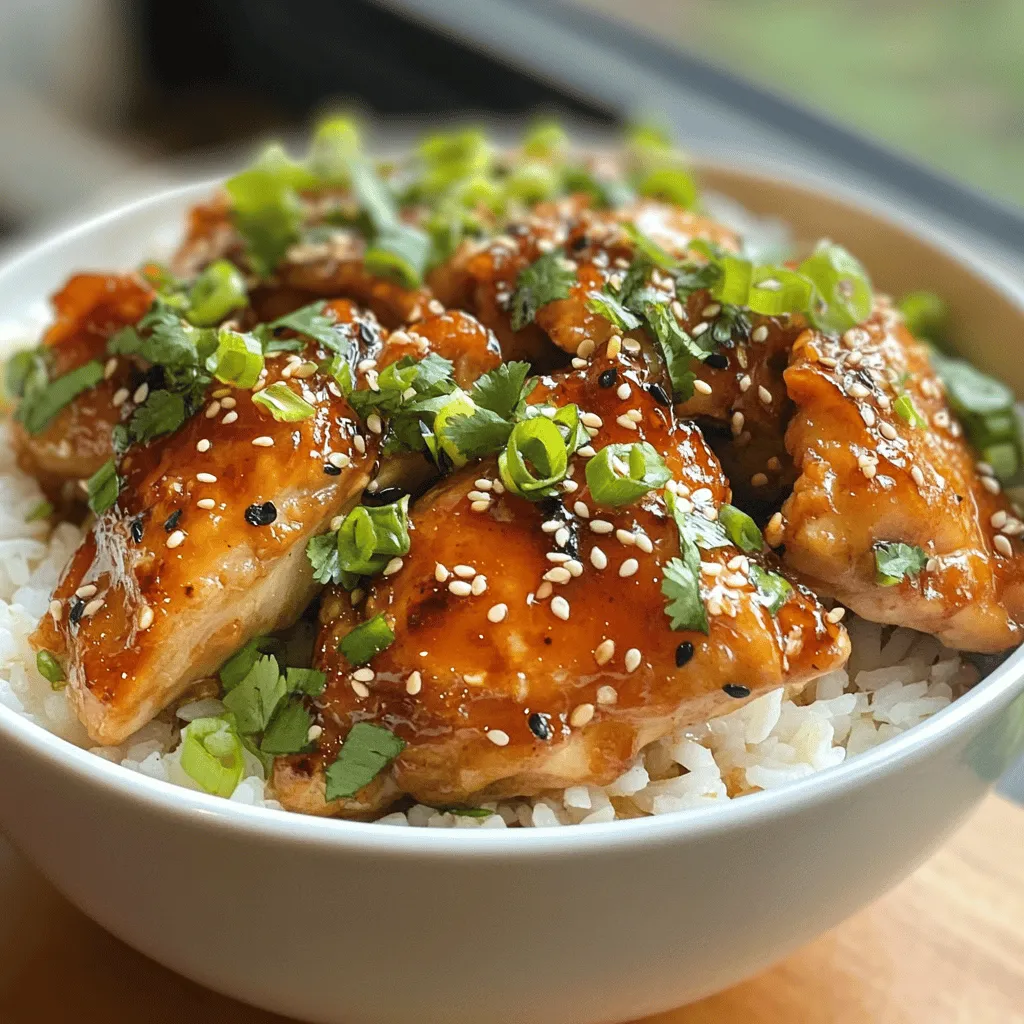When it comes to satisfying meals that combine taste, nutrition, and ease of preparation, the Sticky Chicken Rice Bowls stand out as a crowd-pleaser. This dish masterfully brings together tender, flavorful chicken marinated in a savory-sweet sauce served over perfectly cooked jasmine rice. Each bite is a delightful fusion of flavors that captivates the palate, making it an ideal choice for any occasion, be it a quick weeknight dinner or a meal prep option for busy weekdays.
The Appeal of Sticky Chicken Rice Bowls
What makes Sticky Chicken Rice Bowls so appealing? The answer lies in their versatility and the richness of flavors they offer. This dish seamlessly blends Asian-inspired ingredients, resulting in a meal that is not only delicious but also packed with nutrients. The combination of boneless, skinless chicken thighs, aromatic sauces, and fluffy rice creates a harmonious balance that satisfies hunger and cravings alike.
The ease of preparation is another significant advantage of this recipe. With just a few simple steps, you can transform ordinary ingredients into an extraordinary dish. The marinating process enhances the chicken’s flavor, while the cooking method ensures that the rice is fluffy and perfectly textured. This simplicity is particularly beneficial for home cooks looking to whip up a meal without spending hours in the kitchen.
Sticky Chicken Rice Bowls are also adaptable to various dietary preferences. Whether you prefer a gluten-free option by using tamari instead of soy sauce or want to add more vegetables for a nutrient boost, this recipe allows you to customize it according to your taste and nutritional needs. It’s a dish that can easily cater to families, friends, and even individual palates, making it a go-to for gatherings or simply a cozy night in.
Understanding the Ingredients
To create the perfect Sticky Chicken Rice Bowls, it’s essential to understand the ingredients that contribute to their deliciousness. Let’s take a closer look at the key components of this recipe:
Boneless, Skinless Chicken Thighs
Boneless, skinless chicken thighs are the star of this dish. Unlike chicken breasts, which can become dry when overcooked, thighs are juicier and more forgiving. Their rich flavor and tender texture make them ideal for marinating, as they absorb the sauce beautifully, resulting in flavorful bites that burst with taste.
Soy Sauce
Soy sauce is a staple in many Asian dishes, and for good reason. It adds depth and umami to the chicken, enhancing its natural flavors. The saltiness of soy sauce also helps in tenderizing the meat and providing a savory base for the marinade. For those watching their sodium intake, low-sodium soy sauce can be a great alternative that retains the essential flavor without the added salt.
Honey
Honey plays a crucial role in this recipe by balancing the savory notes of the soy sauce with its natural sweetness. Beyond its flavor-enhancing properties, honey provides several health benefits, such as antioxidants and natural energy. It also contributes to the sticky texture of the chicken, making each bite irresistibly delicious.
Apple Cider Vinegar
Apple cider vinegar adds a tangy acidity to the marinade, which helps brighten the overall flavor profile. This acidity is not only refreshing but also aids in tenderizing the chicken, allowing the flavors to penetrate deeper into the meat. Additionally, apple cider vinegar is known for its health properties, including aiding digestion and providing antioxidants.
Garlic and Ginger
Garlic and ginger are classic aromatics that enhance the flavor of the dish significantly. Garlic brings a pungent, savory depth, while ginger adds warmth and a hint of spice. Both ingredients are also celebrated for their health benefits, including anti-inflammatory properties and immune-boosting effects. When combined, they create a fragrant base that elevates the chicken’s flavor to new heights.
Jasmine Rice
The choice of rice is essential for this dish, and jasmine rice is the perfect option. Known for its fragrant aroma and slightly sticky texture, jasmine rice complements the sticky chicken beautifully. It absorbs the sauce well, ensuring that every bite is filled with flavor. Furthermore, jasmine rice is gluten-free, making it suitable for those with dietary restrictions.
Chicken Broth
Using low-sodium chicken broth instead of water to cook the rice enhances its flavor and richness. The broth infuses the rice with savory notes, making it a delicious accompaniment to the sticky chicken. For a vegetarian option, vegetable broth can be used without sacrificing flavor.
Optional Toppings
The beauty of Sticky Chicken Rice Bowls is that they can be customized with various toppings. Consider adding sliced green onions for a fresh crunch, sesame seeds for added texture, or pickled vegetables for a tangy contrast. You can also incorporate steamed broccoli or other vegetables for a nutritional boost. These toppings not only add visual appeal but also enhance the overall flavor and texture of the dish.
Marinating the Chicken
One of the key steps in preparing Sticky Chicken Rice Bowls is marinating the chicken. Marination is essential for developing deeper flavors and ensuring that the chicken remains tender and juicy throughout the cooking process. Here’s a step-by-step guide on how to marinate chicken thighs effectively:
1. Prepare the Marinade: In a mixing bowl, combine soy sauce, honey, apple cider vinegar, minced garlic, and grated ginger. Whisk until well blended. This mixture will serve as the flavorful base for the chicken.
2. Add the Chicken: Place the boneless, skinless chicken thighs in a resealable plastic bag or a shallow dish. Pour the marinade over the chicken, ensuring that each piece is evenly coated.
3. Seal and Refrigerate: If using a plastic bag, seal it tightly and gently massage the marinade into the chicken. If using a dish, cover it with plastic wrap. Refrigerate for at least 30 minutes. For optimal flavor, marinate the chicken for 2 to 4 hours, or even overnight. This extended time allows the chicken to absorb the flavors thoroughly.
4. Understanding Marination Time: The minimum marination time of 30 minutes is effective for flavor absorption, while longer marination times enhance tenderness. However, avoid marinating for more than 24 hours, as the acidity from the marinade can begin to break down the chicken too much, resulting in a mushy texture.
5. The Science Behind Marinating: Marinating not only enhances flavor but also tenderizes the meat. The acid from the vinegar and the enzymes in the garlic and ginger work to break down protein fibers, resulting in a more succulent chicken. Additionally, marination allows the flavors to penetrate into the meat, ensuring that every bite is packed with taste.
Cooking the Rice
While the chicken is marinating, it’s time to prepare the jasmine rice. Cooking rice may seem straightforward, but there are key steps to ensure the perfect consistency and flavor:
1. Rinse the Rice: Begin by rinsing jasmine rice under cold water. This step is crucial as it removes excess starch that can lead to gummy rice. Rinsing also helps achieve the desired fluffy texture. Rinse until the water runs clear, which indicates that most of the starch has been washed away.
2. Measure the Rice and Liquid: For jasmine rice, the typical ratio is 1 cup of rice to 1.5 cups of liquid. If using chicken broth, measure accordingly, adjusting for the amount of rice you’re cooking. This ratio allows the rice to absorb enough liquid for optimal cooking.
3. Cook the Rice: In a medium saucepan, combine the rinsed rice and the measured liquid. Bring to a boil over medium-high heat. Once boiling, reduce the heat to low, cover the pot, and let it simmer for about 15 minutes. Avoid lifting the lid during cooking, as this can release steam and affect the rice’s texture.
4. Rest the Rice: After cooking, turn off the heat and let the rice sit covered for an additional 10 minutes. This resting period allows the grains to firm up and any remaining moisture to be absorbed, resulting in perfectly cooked rice.
5. Fluff and Serve: After resting, use a fork to gently fluff the rice, separating the grains. This step is crucial for achieving a light and airy texture, making it the perfect base for your sticky chicken.
With the chicken marinating and the rice cooking, you’re well on your way to creating a delicious and satisfying meal. The combination of flavors and textures in Sticky Chicken Rice Bowls is sure to delight your taste buds, making this recipe a go-to for many culinary occasions.
Stay tuned for the next steps in the preparation process, where we will guide you through cooking the marinated chicken and assembling your delicious Sticky Chicken Rice Bowls!

Explanation of Using Chicken Broth Instead of Water for Enhanced Flavor
When preparing Sticky Chicken Rice Bowls, one of the simplest yet most impactful enhancements you can make is to use chicken broth instead of water for cooking the rice. Chicken broth is rich in flavor and adds depth to the dish, infusing the rice with savory notes that elevate the overall taste experience. The broth not only complements the chicken but also binds the various elements together, creating a cohesive flavor profile that makes each bite a delight.
Using broth is an easy upgrade that can transform a basic dish into something extraordinary. It’s particularly beneficial for those who might find plain rice too bland or uninteresting. Opt for low-sodium chicken broth to maintain control over the saltiness of your dish, ensuring that you can balance flavors effectively.
Cooking the Chicken
Techniques for Searing Chicken to Achieve a Perfect Glaze
The chicken is the star of the Sticky Chicken Rice Bowls, and achieving a perfect sear is crucial for both flavor and texture. Start by patting the chicken pieces dry with paper towels to ensure a good sear. Moisture on the surface can create steam, which prevents browning.
Heat a tablespoon of oil in a large skillet over medium-high heat. Once the oil shimmers, add the chicken pieces without overcrowding the skillet. Searing in batches is advisable if you have a large amount of chicken. Avoid moving the chicken around too much; let it cook undisturbed for several minutes to develop a golden-brown crust. This caramelization not only enhances the flavor but also creates a beautiful glaze when you add the reserved marinade later.
Importance of Temperature Control in Cooking Chicken
Temperature control is vital in cooking chicken to ensure it is both flavorful and safe to eat. Use a meat thermometer to check for doneness; the internal temperature should reach 165°F (75°C). Cooking at medium-high heat allows for a good sear while ensuring the chicken cooks through without drying out.
If the chicken starts to brown too quickly, reduce the heat slightly. Once the chicken is seared on both sides, you can lower the heat further and add the reserved marinade to create a thick, sticky glaze. This method not only ensures that the chicken is fully cooked but also allows the flavors from the marinade to infuse into the meat, enhancing the overall taste of your dish.
How to Effectively Use the Reserved Marinade to Create a Thick Sauce
The reserved marinade is a powerhouse of flavor that can be transformed into a delightful sauce. After the chicken has been seared, pour the marinade into the same skillet, scraping up any browned bits from the bottom. This step is critical as it incorporates all the flavors from the pan, adding richness to your sauce.
Allow the marinade to simmer for a few minutes until it thickens slightly. The sugars from the marinade will caramelize, creating a sticky glaze that clings beautifully to the chicken. This glaze is what gives the dish its name, so don’t rush this step. Once the sauce has thickened and the chicken is evenly coated, remove it from heat, and prepare to assemble your bowls.
Assembling the Bowls
Step-by-Step Guide to Assembling the Rice Bowls
Assembling your Sticky Chicken Rice Bowls is the moment where all your hard work pays off. Here’s a step-by-step guide:
1. Start with the Base: Spoon a generous serving of the flavorful chicken broth-infused rice into a bowl.
2. Add the Chicken: Place the glazed chicken on top of the rice. Arrange the pieces neatly, ensuring that each bowl gets an equal share of the sauce.
3. Incorporate Vegetables: If you have prepared any vegetables such as steamed broccoli, snap peas, or sautéed bell peppers, arrange them around the chicken for color and nutrition.
4. Top It Off: Finish the bowl with your choice of toppings, which we will discuss further in this article.
Importance of Presentation and How It Enhances the Dining Experience
While taste is paramount, presentation plays a significant role in enhancing the dining experience. A well-assembled bowl not only looks appetizing but also makes the meal more enjoyable. Use contrasting colors for your toppings and vegetables to create visual appeal.
Consider using a shallow bowl to allow the ingredients to be seen from above, showcasing the vibrant hues of green, orange, and golden chicken. A sprinkle of sesame seeds or chopped cilantro can add the finishing touch that makes your bowl Instagram-worthy, inviting everyone to dig in.
Suggestions for Portioning for Various Appetites
Understanding portion sizes can help cater to different appetites. For a light meal, serve about half a cup of rice with one piece of chicken and a few vegetables. For heartier appetites, increase the rice to a full cup, add two pieces of chicken, and pile on the veggies.
Encouraging customization allows everyone at the table to tailor their bowls to their liking, making Sticky Chicken Rice Bowls a versatile option for family meals or gatherings.
Adding the Toppings
Role of Toppings in Enhancing Flavor and Texture
Toppings are essential for adding layers of flavor and texture to your Sticky Chicken Rice Bowls. They not only enhance the dish’s visual appeal but also introduce fresh elements that balance the richness of the glazed chicken.
Discussing the Benefits of Green Onions, Cilantro, Pickled Vegetables, and Sesame Seeds
- Green Onions: Chopped green onions offer a mild onion flavor and a crisp texture that complements the tender chicken and fluffy rice.
- Cilantro: Fresh cilantro adds a burst of herbaceous notes and brightness, cutting through the richness of the sauce.
- Pickled Vegetables: Pickled carrots or cucumbers provide a tangy crunch that contrasts beautifully with the sticky chicken.
- Sesame Seeds: Toasted sesame seeds introduce a nutty flavor and a delightful crunch, rounding out the dish.
Creative Variations on Toppings for Personalization
Feel free to get creative with your toppings. Consider adding avocado slices for creaminess, sliced jalapeños for a spicy kick, or even fried shallots for a crunchy texture. You can also experiment with different herbs, such as mint or basil, to give your dish a unique twist. The beauty of rice bowls lies in their versatility, so don’t hesitate to adapt them to your taste preferences.
Nutritional Information
Breakdown of Nutritional Benefits of the Dish
Sticky Chicken Rice Bowls are not only delicious but also nutritionally balanced. Here’s a breakdown of the benefits:
- Protein: The chicken provides a substantial amount of protein, essential for muscle repair and overall health.
- Carbohydrates: The rice serves as a source of carbohydrates, giving you the energy needed for an active lifestyle.
- Vitamins and Minerals: Fresh vegetables and herbs contribute vitamins A and C, fiber, and essential minerals.
Discussion on How This Dish Fits into a Balanced Diet
Incorporating Sticky Chicken Rice Bowls into your diet can fit well into a balanced meal plan. The combination of protein, carbohydrates, and fresh produce ensures that you are getting a variety of nutrients. Adjusting the portion sizes and adding more vegetables can make it even healthier, appealing to those looking for nutritious meal options.
Considerations for Dietary Restrictions or Preferences (e.g., Gluten-Free Options)
This recipe can easily be adapted for various dietary preferences. To make it gluten-free, ensure that your soy sauce is gluten-free or substitute it with coconut aminos. Additionally, you can swap the rice for quinoa or cauliflower rice for a lower-carb option, making it suitable for those with dietary restrictions.
Serving Suggestions
Ideas for Side Dishes That Complement the Rice Bowls
While Sticky Chicken Rice Bowls are a complete meal on their own, you can enhance the dining experience by serving some complementary side dishes. Consider:
- Miso Soup: A warm bowl of miso soup can offer a comforting contrast to the rice bowls.
- Asian Slaw: A fresh slaw made with cabbage, carrots, and a sesame dressing can add crunch and freshness.
- Steamed Dumplings: Light dumplings filled with vegetables or chicken can serve as a delightful side.
Recommendations for Beverages That Pair Well with the Dish
Pair your rice bowls with beverages that complement the flavors of the dish. Green tea is a classic choice that provides a refreshing contrast. For something a bit stronger, consider serving light beer or sake. A fruity iced tea can also be a great non-alcoholic option that adds a touch of sweetness to balance the savory elements of the meal.
Conclusion
In summary, Sticky Chicken Rice Bowls offer a delightful combination of flavors, textures, and colors that make for a satisfying meal. Using chicken broth instead of water, searing the chicken to perfection, and thoughtfully assembling the bowls are key to creating this dish. The toppings add freshness and personalization, while the nutritional benefits ensure that it fits well into a balanced diet.
I encourage you to try this recipe and explore the many variations you can create. Cooking at home not only allows you to enjoy delicious meals but also provides the joy of experimenting with flavors and ingredients. Sticky Chicken Rice Bowls are not just a meal; they are an experience that brings comfort and satisfaction, perfect for any occasion. Happy cooking!


